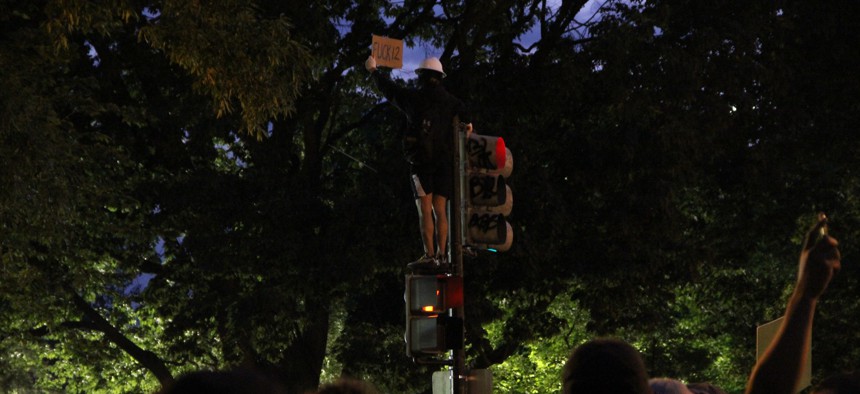
Protesters outside of the White House on June 2, 2020. Katie Bo Williams
Quieter Night In DC As Protests Continue Amid Large Militarized Response Force
The show-of-force angered protesters, but the crowds eventually dwindled without much police intervention.
On the fifth day of demonstrations in Washington, D.C., on President Donald Trump’s order, a heavily-armed response force made up of multiple military and law enforcement agencies flooded the streets of the nation’s churning capital.
The show-of-force at least appeared to have contributed to the president’s desired effect. Although the crowd gathered at the White House appeared to be the largest grouping yet, and even as angry protesters pushed back against Trump’s militarized response to the unrest, Tuesday night was notably peaceful, with significantly less violence and looting.
Across the street from the White House, an eight foot-high fence strung together by heavy-duty steel bars and U-bolts went up around Lafayette Square, separating protesters from a line of Capital Park Police and camouflaged officers marked “military police.” A parade of National Guard personnel carriers and Humvees rolled down some of Washington, D.C.’s most famous thoroughfares. By late afternoon, units were stationed on street corners across the capital, directing traffic, closing off blocks from vehicle traffic and occasionally engaging with frustrated protesters. Units from the FBI, Bureau of Prisons, and DEA in paramilitary uniforms were scattered across the city. At the Lincoln Memorial, other camouflaged officers with no insignia identifying their agency squared off with protesters. At least one Black Hawk helicopter hovered overhead.
Just outside of the city, 1,600 troops from Fort Bragg, in North Carolina, and Fort Drum, in New York were stationed in a stand-by capacity — ”on heightened alert status,” according to the Pentagon — in case Trump invokes a controversial law that would allow him to use active-duty military to help quell the unrest.
The addition of so much military — or militarized — personnel was an escalation of the sort that Trump promised Monday that he would order. And for some protesters, the distinction between local Guard members wearing their camouflage uniforms in the city and active duty troops was immaterial.
“Why is the military here? Why?!” screamed one protester walking past Guardsmen who was stationed on a corner a few blocks from the White House directing traffic. “Grow a brain!”
It’s unclear the extent to which the visible show of force was responsible for the relative calm of Tuesday compared to the two previous nights, when police and security forces violently disrupted some demonstrations, and some among the protesters lit fires and looted stores across the city. The most incendiary episode of Monday night — the use of tear gas to clear protesters from the square for a presidential photo op — was not repeated and protesters, separated physically from police by the fence, could often be seen policing themselves. As the sun fell and many headed home, some who remained began to throw water bottles and other objects over the fence at police, only to be shouted down by the crowd, which chanted: “Peace-ful pro-test!”
Many protesters reported on Tuesday that they felt compelled to come out in response to the tear gas incident, creating one of the largest demonstrations yet. Hundreds of protesters remained on site far beyond D.C. Mayor Muriel Bowser’s 7 p.m. curfew, but law enforcement officers did not move to clear the crowd and it thinned out of its own accord after only a few altercations between police and protesters.
Tuesday’s protests were “peaceful,” said one Guard member who spoke on the condition of anonymity. “Just yelling stuff like that, not hurting anyone, not doing anything and that’s exactly what their right is,” he said, referring to the protester who had yelled “Why is the military here?”
“The last protest that came through, the sense of community I thought was pretty cool,” he continued. “Unfortunately shit doesn’t change always. Hopefully there is a change.”
The Trump administration on Tuesday sought to defend itself against a wave of criticism over its handling of the protests on Monday night. Defense Secretary Mark Esper denied knowing about the plan to clear Lafayette Square in advance, and claimed that he thought that the president was taking him to view a graffitied bathroom in the square — not to the church for a photo. A senior defense official denied that National Guard members had used tear gas on protesters in the square, and defended Esper’s assertion that government officials needed to “dominate the battlespace,” a startling reference to American streets. The D.C National Guard has launched an investigation into the deployment of Blackhawk helicopters that hovered so low over the city that tree branches broke in the rotor wash.
The president does not have the legal authority to deploy active duty troops to conduct law enforcement without invoking the Insurrection Act — which he threatened to do but did not on Monday — and state governors quickly fired back on his announcement that he had ordered “thousands and thousands of heavily armed soldiers, military personnel, and law enforcement officers” to quell civil unrest in Washington, D.C.
“If a city or state refuses to take the actions that are necessary to defend the life and property of their residents, then I will deploy the United States military and quickly solve the problem for them.”
The Trump administration’s militarized rhetoric and response to the crisis has deeply unnerved scholars of civil-military relations, many of whom note that the military is forbidden under the 1878 Posse Comitatus Act from practicing domestic law enforcement unless explicitly authorized by statute. If the president invokes the Insurrection Act, which stipulates that the president determine “as a result of a natural disaster [that] domestic violence has occurred to such an extent that the constituted authorities of the State or possession are incapable of maintaining public order,” he could use both federalized National Guard troops and regular military forces for law enforcement purposes. But critics say that further militarizing the government’s response will only inflame tensions and heighten policing disparities that spurred the unrest in the first place.
"Violence has no place and violence must be addressed," House Speaker Nancy Pelosi told NPR. "But there is no reason for the U.S. military to be called out for this."




